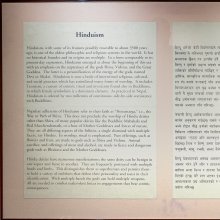Matsyendranatha, Matsyendra-natha, Matsyendranātha: 4 definitions
Introduction:
Matsyendranatha means something in Hinduism, Sanskrit. If you want to know the exact meaning, history, etymology or English translation of this term then check out the descriptions on this page. Add your comment or reference to a book if you want to contribute to this summary article.
Images (photo gallery)
In Hinduism
Shaivism (Shaiva philosophy)
Source: Google Books: Manthanabhairavatantram (shaivism)1) Matsyendranātha (मत्स्येन्द्रनाथ) is worshipped as the teacher of this Age along with three other teachers and their consorts who brought the Kaula Tantra into the world in the previous three Ages. These four Lords of the Ages (yuganātha) are highly revered in the Kālīkrama and came to be considered to be embodiments of the basic states of consciousness. According to the Mahānayaprakāśa by Arṇasiṃha, they are projected into the cycle of persistence (sthiticakra) as they generally are in the Kālīkrama.
Matsyendranātha has a variety of cognate names (Cf. Dyczkowski 1988: 163 n23).—Bagchi lists the following names found in the sources he edited: Macchagnapāda, Macchendrapāda, Matsyendrapāda, Mīnapāda, Mīnanātha, Macchendapāda, Matsyendra, and Macchindranāthapāda. He notes (1934: 6) that: ‘the forms Macchendra, Macchenda and Macchindra are all colloquial variants of the name Matsyendra’.
Consort of Matsyendra: According to the Kulakrīḍāvatāra-tantra and Ciñcinīmatasārasamuccaya: Kuṅkunāmbā; according to the Devīpañcaśatikā: Koṃkaṇāmbā.
Disciples of Matsyendra: According to the Kulakrīḍāvatāra-tantra and Ciñcinīmatasārasamuccaya: Twelve Princes
2) Matsyendranātha (मत्स्येन्द्रनाथ) or Macchanda is the name of a deity, according to the Tantrāloka verse 1.7.—Accordingly, “May he, the pervasive Lord Macchanda (the Fisherman) be pleased with me, he who has cast along the outer path the net (of Māyā) which, spreads and extends (in all directions) and red with attachment, strewn with knots and holes, is made of many parts”.
Source: DSpace at Pondicherry: Siddha Cult in Tamilnadu (shaivism)Matsyendranātha (मत्स्येन्द्रनाथ) or Mīnanātha refers to the third representation of the nine navanātha reliefs in the Ulsūr Someśvara temple. Matsyendranātha is believed to have lived in 9th - 10th centuries C.E. According to legends, he is the first incarnāte teacher of the Nātha-yogi movement and the reputed founder of the Haṭha-yoga system, along with his disciple Gorakṣanātha. He composed an important Tāntric work Kaulajnanirnaya, and also found one of the Kaula schools called Yogini-Kaula
According to Skanda Purāna, Matsyendranātha was born as Lokeśvarā on an inauspicious day, so his family threw him into the sea, where he was swallowed by a fish and overheard the secret, conversation about yoga between Śiva and Pārvati, on the shore of an island. Pārvati had fallen asleep but Lokeśvarā heard everything. In this version of the legend, Śiva is pleased and, as Lokeśvarā comes out of the fish, he gives him the name Matsyendranātha, “Lord of the Fishes”. Later versions of the legend say that Pārvati became angry with Lokeśvarā and banished him to Kadali, the Kingdom of Women, to forget the secrets of yoga.
Source: Nirvāṇa Sundarī: A Note on Kula and Kaula TantraMatsyendranātha (मत्स्येन्द्रनाथ) is the name of the Kula-tantra Guru in the kaliyuga.—Abhinavagupta describes four Gurus for Kula Tantra based on the Yuga. Khagendranātha in satyayuga, Kūrmanātha in tretāyuga, Meṣanātha in dvāparayuga and Matsyendranātha for kaliyuga. During the Gurumaṇḍala Krama, one worships Khagendranātha and Vijjāmbā in East, Kūrmanātha and Maṅgalāmbā in the South, Meṣanātha and Kāmamaṅgalāmbā in West and Matsyendranātha and Koṅkaṇāmbā in the North.
Matsyendranātha had six sons who were also his disciples and they propagated his teachings:
- Amaranātha,
- Varadeva,
- Citranātha,
- Alinātha,
- Vindhyanātha
- and Guṭikānātha.
Through these six sons authorized by Matsyendranātha, the Kula santati is known to have propagated. The word ‘kula’ or ‘clan’ thus originally refers to the clan of Matsyendranātha.

Shaiva (शैव, śaiva) or Shaivism (śaivism) represents a tradition of Hinduism worshiping Shiva as the supreme being. Closely related to Shaktism, Shaiva literature includes a range of scriptures, including Tantras, while the root of this tradition may be traced back to the ancient Vedas.
Shaktism (Shakta philosophy)
Source: Google Books: ManthanabhairavatantramMatsyendranātha (मत्स्येन्द्रनाथ) (or Mīna) is the name of a deity, according to the second recension of the Yogakhaṇḍa of the Manthānabhairavatantra, a vast sprawling work that belongs to a corpus of Tantric texts concerned with the worship of the goddess Kubjikā.—Accordingly, as Śrīnātha (i.e., Bhairava) said to the Goddess: “[...] Once the scripture of (that) mountain (śilāgama) [i.e., the mountain (śilā) (of the Triangle)] , Kula and Kaula was worshipped there with devotion, the great goddess was worshipped and lauded by men and the rest. The one called Mīna (i.e. Matsyendranātha) was present there. He became fully accomplished (siddha) there in that House”.

Shakta (शाक्त, śākta) or Shaktism (śāktism) represents a tradition of Hinduism where the Goddess (Devi) is revered and worshipped. Shakta literature includes a range of scriptures, including various Agamas and Tantras, although its roots may be traced back to the Vedas.
See also (Relevant definitions)
Partial matches: Matsyendra, Natha.
Full-text (+162): Gorakshanatha, Mina, Khagendranatha, Meshanatha, Citranatha, Amaranatha, Vindhyanatha, Alinatha, Varadeva, Gutikanatha, Minanatha, Macchagnapada, Minapada, Macchindranathapada, Matsyendrapada, Macchendapada, Macchenda, Macchindranatha, Macchendranatha, Macchagna.
Relevant text
Search found 8 books and stories containing Matsyendranatha, Matsyendra-natha, Matsyendranātha, Matsyendra-nātha; (plurals include: Matsyendranathas, nathas, Matsyendranāthas, nāthas). You can also click to the full overview containing English textual excerpts. Below are direct links for the most relevant articles:
The Skanda Purana (by G. V. Tagare)
Chapter 263 - Origin of Matsyendranātha (Matsyendra-nātha) < [Section 1 - Tīrtha-māhātmya]
Varahi Tantra (English Study) (by Roberta Pamio)
Chapter 26 - Haṭhayoga (according to the Haṭhayogapradīpikā) < [Summary of the Vārāhī Tantra]
Lord Hayagriva in Sanskrit Literature (by Anindita Adhikari)
Origin of Tantra < [Chapter 6]
Preceptors of Advaita (by T. M. P. Mahadevan)
(i) Jñānadeva < [56. Some Authors of Works in Regional Languages]
A History of Indian Philosophy Volume 5 (by Surendranath Dasgupta)
Part 1 - History and Literature of Vīra-śaivism < [Chapter XXXV - Vīra-śaivism]
Related products

